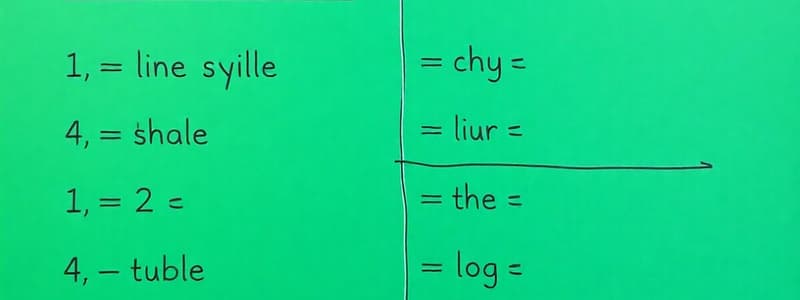Podcast
Questions and Answers
How should the word 'beginner' be divided?
How should the word 'beginner' be divided?
- be-gin-ner
- begin-ner (correct)
- beg-inner
- begin-ner (correct)
A word that ends in -le typically divides with the consonant before -le in a separate syllable.
A word that ends in -le typically divides with the consonant before -le in a separate syllable.
True (A)
What is the correct syllable division for the word 'collect'?
What is the correct syllable division for the word 'collect'?
col-lect
The word 'traffic' divides into _____.
The word 'traffic' divides into _____.
Match the words with their correct syllable divisions:
Match the words with their correct syllable divisions:
What is the primary rule regarding dividing words?
What is the primary rule regarding dividing words?
It is acceptable to divide one-syllable words.
It is acceptable to divide one-syllable words.
What should you do when in doubt about word division?
What should you do when in doubt about word division?
Do NOT divide a one-letter syllable at the _____ or the end of a word.
Do NOT divide a one-letter syllable at the _____ or the end of a word.
When dividing a word, at least how many characters should remain on the upper line?
When dividing a word, at least how many characters should remain on the upper line?
Match the word with its correct division method:
Match the word with its correct division method:
Avoid dividing any word with fewer than _____ letters.
Avoid dividing any word with fewer than _____ letters.
It is acceptable to divide abbreviations.
It is acceptable to divide abbreviations.
What is the preferred method of dividing a word that contains a prefix?
What is the preferred method of dividing a word that contains a prefix?
It is acceptable to divide the word 'interrogate' as in-ter-rogate.
It is acceptable to divide the word 'interrogate' as in-ter-rogate.
What should be the division point for the word 'helplessness'?
What should be the division point for the word 'helplessness'?
Divide the word 'reinvest' at the appropriate point: re-______.
Divide the word 'reinvest' at the appropriate point: re-______.
Match the following words with their preferred division points:
Match the following words with their preferred division points:
Which division of 'ambidextrous' would be considered confusing?
Which division of 'ambidextrous' would be considered confusing?
The word 'reinvent' should be divided as rein-vent.
The word 'reinvent' should be divided as rein-vent.
What is the preferred division of the word 'international'?
What is the preferred division of the word 'international'?
Where can a break occur in a street name consisting of two or more words?
Where can a break occur in a street name consisting of two or more words?
A city name can be divided from a state name.
A city name can be divided from a state name.
What should be preferred for breaking a person's name?
What should be preferred for breaking a person's name?
A sentence with a _______ in it may be broken after the dash.
A sentence with a _______ in it may be broken after the dash.
Match the punctuation mark with its usage:
Match the punctuation mark with its usage:
Which is the correct syllabication for the word 'children'?
Which is the correct syllabication for the word 'children'?
A numbered enumeration may be broken directly after the number.
A numbered enumeration may be broken directly after the number.
What is an example of correct syllabication for the word 'product'?
What is an example of correct syllabication for the word 'product'?
Which of the following words is correctly divided?
Which of the following words is correctly divided?
Do you divide between two vowels representing one sound?
Do you divide between two vowels representing one sound?
What is the appropriate division for the word 'cooperate'?
What is the appropriate division for the word 'cooperate'?
When dividing a long number, always divide after a _____ .
When dividing a long number, always divide after a _____ .
Match the following examples with their division rules:
Match the following examples with their division rules:
Where should the last word be when dividing lines?
Where should the last word be when dividing lines?
You should try to end more than two consecutive lines with hyphens.
You should try to end more than two consecutive lines with hyphens.
What should you use between elements of a word group that should not be broken?
What should you use between elements of a word group that should not be broken?
Flashcards
Word Division Rules
Word Division Rules
Specific rules for dividing words into syllables for better readability and understanding.
Divide after prefix
Divide after prefix
Divide a word after the prefix rather than within it to improve readability.
Avoid confusing divisions
Avoid confusing divisions
Avoid divisions that can create ambiguity or confuse the reader, such as dividing within prefixes.
Divide before suffix
Divide before suffix
Signup and view all the flashcards
Prefix and Suffix Combination
Prefix and Suffix Combination
Signup and view all the flashcards
Multiple Suffixes
Multiple Suffixes
Signup and view all the flashcards
Preferred Division Points
Preferred Division Points
Signup and view all the flashcards
Confusing Divisions
Confusing Divisions
Signup and view all the flashcards
Syllable Division Rules
Syllable Division Rules
Signup and view all the flashcards
One-Syllable word division
One-Syllable word division
Signup and view all the flashcards
One-letter syllable division
One-letter syllable division
Signup and view all the flashcards
Minimum syllable length
Minimum syllable length
Signup and view all the flashcards
Compound words
Compound words
Signup and view all the flashcards
Hyphenated compound word
Hyphenated compound word
Signup and view all the flashcards
Abbreviations
Abbreviations
Signup and view all the flashcards
Contractions
Contractions
Signup and view all the flashcards
Syllable Division (One-Letter Syllable)
Syllable Division (One-Letter Syllable)
Signup and view all the flashcards
Syllable Division (Vowels)
Syllable Division (Vowels)
Signup and view all the flashcards
Syllable Division (Single Vowel Sound)
Syllable Division (Single Vowel Sound)
Signup and view all the flashcards
Long Number Division
Long Number Division
Signup and view all the flashcards
Word Group Preservation
Word Group Preservation
Signup and view all the flashcards
Address Division
Address Division
Signup and view all the flashcards
Nonbreaking Spaces
Nonbreaking Spaces
Signup and view all the flashcards
Line Breaks (General Guidelines)
Line Breaks (General Guidelines)
Signup and view all the flashcards
Street name breaks
Street name breaks
Signup and view all the flashcards
Place name breaks
Place name breaks
Signup and view all the flashcards
Person name breaks
Person name breaks
Signup and view all the flashcards
Title/name breaks
Title/name breaks
Signup and view all the flashcards
Department name breaks
Department name breaks
Signup and view all the flashcards
Enumeration breaks
Enumeration breaks
Signup and view all the flashcards
Dash break
Dash break
Signup and view all the flashcards
Ellipsis break
Ellipsis break
Signup and view all the flashcards
Double Consonant Rule (Suffix)
Double Consonant Rule (Suffix)
Signup and view all the flashcards
Double Consonant Rule (Base Word)
Double Consonant Rule (Base Word)
Signup and view all the flashcards
Two Consonants Between Vowels
Two Consonants Between Vowels
Signup and view all the flashcards
Single Consonant with Long Vowel
Single Consonant with Long Vowel
Signup and view all the flashcards
Single Consonant with Short Vowel
Single Consonant with Short Vowel
Signup and view all the flashcards
Study Notes
Syllable Division Rules
- Electronic dictionaries may not always agree on word division.
- Regularly review electronic word divisions and adjust as needed.
- Avoid dividing words at the end of lines whenever possible.
- Divide words between syllables. When unsure, consult a dictionary.
- Do not divide one-syllable words, even if "-ed" is added.
- Example: stress/stressed, through/through, spring/spring, rhythm/rhythm, planned/planned
- Do not divide one-letter syllables at the beginning or end of a word, e.g. amaze (not a-maze), media (not medi-a), idea (not i-dea). Some dictionaries omit these now.
- Use a hard hyphen, not a soft one when typing words like e-mail to avoid dividing the word after the "e".
- Do not split a word unless you can leave at least three characters of a syllable on the top line, and similarly leave at least three characters of the next syllable on the bottom line.
- Avoid dividing words with fewer than six letters.
- Do not divide abbreviations. (e.g., ACTION, UNICEF, AMVETS, NASDAQ)
- Do not divide contractions (e.g., haven't, shouldn't).
Basic Rules
- Divide compound words where it's meant to separate components, and hyphenated compound words at the hyphen. Eg., eye-witness, time-saving, photo-copy, base-ball, self-confidence.
- Divide words after a prefix, rather than within the prefix. Example (Preferred/Acceptable)
- intro-/troduce
- inter-/in-
- national/international
- super-/ter-/national
- Avoid confusing divisions (Avoid/Better). Example:
- inter-/in- (e.g., interrogate/terrogate)
- super-/su- (e.g., super/terrogation)
- Put the suffix before the root word (not in the middle), and consider the division to be the most intelligible grouping of syllables possible.
- Examples (preferred/not preferred): applicable/applica-ble, comprehensive/comprehensi-ble, encouragement/en-couragement.
- When dividing, divide after a prefix or before a suffix, rather than within the root word. Eg., over-active, succesful. (rather than overactive or succ-essful).
- When a one-letter syllable occurs in the root of a word, divide after it (not before). Eg. imperative, pen-etrate, similar, congratulate.
- If two or more separate vowels come together in a word, divide between the separate vowels.
- Examples: recreation, mediation, proactive, situated.
- Do not divide between vowels when they are used together to represent one sound. Examples: maintain, treasurer, encroaching, ac-quaint.
- If splitting is necessary, ensure the number remains as separate parts, for example, 24,358, -692,000, and when possible, follow the rules to ensure there are at least 4 digits on the line above and 6 digits on the next.
Preferred Practices
- It is often better to divide in more meaningful points than where suggested by dictionaries.
- Use divisions based on syllable groupings which provide the most intelligible groupings of words (preferred grouping).
Breaks Within Word Groups
- Try to avoid separating items in word groups that belong together. For example, name, number, city, etc. and month and year etc should usually be put on the same line.
- Insert hard spaces if necessary.
Further Rules
- When necessary, divide long numbers after a comma; try to keep at least 4 digits above, and 6 digits below.
- Avoid two consecutive line ends with hyphens, and avoid dividing the last word on a page.
- A sentence divided by a dash should be broken after the dash.
- If splitting is necessary, preferably segment a sentence after a period/ellipsis.
- When there are double consonants, before suffixes, divide after them. For example, sellers, staffing, blessing, buzzers.
- If there are double consonants within a root word but before a suffix, divide between the two consonants if adding the suffix creates an extra syllable. Examples: beginning, omitted, shipping, referral.
- Divide words between consonants when there are two consonants between two pronounced vowels. Eg; pic-ture, sen-tence, in-vent.
- If a single consonant comes between two vowels, and the first vowel is long / accented, the consonant goes with the second vowel e.g., si-lent, fo-cus.
- If a single consonant comes between two vowels, and the first vowel is short / accented, the consonant stays with the first vowel. Eg., piv-ot, met-al, mag-ic.
- When the word ends in -le, the consonant before the -le forms a syllable. Eg. hum-ble, sta-ble, un-cle.
- Syllabication is based on pronunciation, not root words. Example; knowledge/knowl-edge and children/chil-dren.
Studying That Suits You
Use AI to generate personalized quizzes and flashcards to suit your learning preferences.




